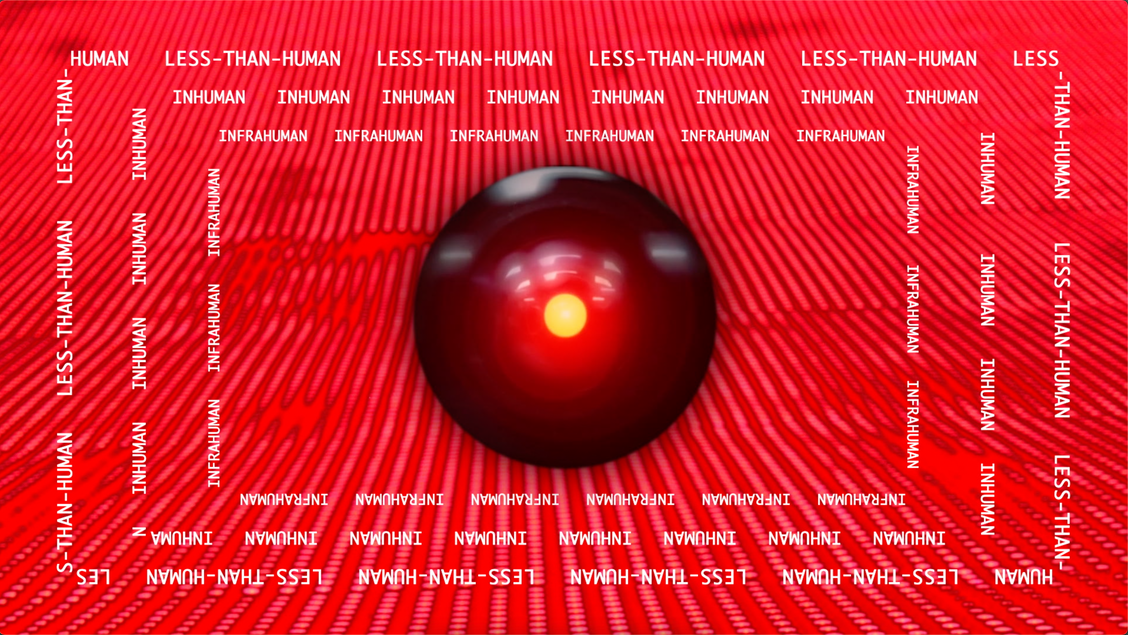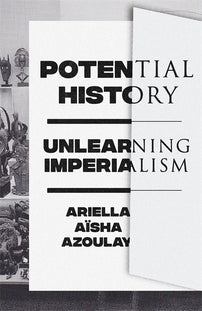Imagine Going on Strike: Intelligent Machines
Artist and scholar Paula Gaetano Adi asks: can we consider robots as comrades? Can we imagine robots going on strike against their own instrumentation? Part of the larger Verso roundtable on "Unlearning Imperialism."

This essay is from the larger roundtable, "Unlearning Imperialism: Responses to Ariella Aïsha Azoulay's Potential History."
* * * * *
Imagine robots going on strike.
Imagine artificial intelligent machines refusing to perform.
Think about a group of AI beings refusing to compute numbers or execute their pre-programmed tasks. Imagine a group of automated machines boycotting an assembly line. Imagine all automated financial advisors refusing to scan and predict the best portfolio or stock based on relevant financial and market data. Imagine drones refusing to fly, refusing to fire missiles, refusing to surveille borders and to patrol communities. Imagine bots withdrawing from analyzing medical data, filtering our social networks, or recognizing our voices and faces when we use our personal phones.
Yes, let’s admit it, a scenario like this is not so difficult imagine; doesn’t require much imagination. We have seen this movie before. Many times, in fact. The idea of a robot uprising, a revolt or a robot strike is as old as our ideas about robots and early automatons. An authentic Robocapocalypse: a scenario in which machines become self-aware and start planning to take over the world; robots going out of control executing a full-blown attack on humanity.
I agree, this is a quite familiar narrative that requires very little imagination. Even if we go back when the word robot first appeared in 1921 in Karel Čapek’s original play Rosum’s Universal Robots, robots formed a revolutionary strike aimed at emancipating from the oppression, and army to destroy the “human race.” A narrative that certainly echoes Mary Shelley’s Frankenstein and set the tone of all Western characterizations of robots as slaves straining against their human master: Terminator, HAL 9000, Blade Runner’s replicants, to name a few popular examples.
But I would like to propose to imagine the possibility of a robot strike from a different lens. A lens that is attuned with the kind of radical imagination that Ariella Azoulay’s book calls for. An act of imagination that it is not a mere reenactment of imperialist narratives but an onto-epistemic project—as Azoulay calls it—in which violence (for which we are all complicit) can be reversed. I would try, then, to think-with Azoulay what could it mean to unlearn these imperial robocapocalyptic narratives and to rehearse a “potential history” of robotics and artificial life.
Ariella’s book is not only a thorough analysis and study of the ways in which imperialism has segmented populations, shuttered communities, plunder people’s culture and modes of lives, but—above all—is an emphatic, urgent, and elaborated call to action to repair our broken world. A call to act, not today for a better tomorrow, but to act “yesterday”–outside the temporality of progress and the future-thinking and destructive rhetoric that imperialism has devised for us. A call “to rewind,” to begin the reparation of our world by looking at the past and the institutions, the tools and the political devices that facilitated not only the destruction of worlds, people and objects, but fundamentally initiated what she calls the “production of carelessness” for our common world.
But how to begin to act in the past? one may ask. Azoulay is quite clear and straight forward about that: by unlearning, withdrawing, disowning, striking, disengaging; and at the same time by imagining and rehearsing spaces for reparation.
Azoulay proposes to unlearn those institutions that make our word: the archive, the museum, and a variety of political devices such as sovereignty, human rights, democracy, independence, or occupation. However, the generosity of her book is that it also allows us to imagine all other possible spaces for intervention in which we can operate reparations–begging with own disciplines and fields of expertise.
That is precisely what I thought to do here. I decided to use Azoulay’s work as my companion in a journey to unlearn the imperialisms performed by digital technologies, and to imagine scenarios within my own art and scholarly practice in which we can exercise the “principle of reversibility” that she calls for.
Therefore, while thinking-with Ariella’s book, I propose not to imagine a robotic strike as the world’s debacle, but as our opportunity for reparations. Not as the apocalyptic scenario that Hollywood, science, and tech corporations want us to believe, but as a way out to capitalism, modernity and colonization; as our opportunity for rewinding and unlearning the imperial violence inflicted by digital technologies, artificial intelligence, data analysis, and machine learning. I propose to think of robots as are our comrades in the flight for repairing our shared world.
For that, I take on Ariella’s proposal to go back to 1492 as the “marker of reversibility,” and I imagine that the origins of AI technology go back to the fifteenth century. Azoulay’s lessons and arguments on the camera shutter are particularly helpful here in helping us identify not only the photographic device as a synecdoche for the operation of the imperial enterprise, but to think of other technologies that are also crucial in establishing a “differential body politics” necessary to justify and reproduce imperial and destructive practices. Azoulay claims: “Unlearning photography means to foreground the regime of imperial rights that made its emergence possible.” Likewise, I argue that unlearning robotics means to foreground an imperial regime of forced labor, exploitation, rationalization, and instrumentality that made possible the emergence and flourishing of this technology.
“Imagine that the origins of photography,” continues Azoulay, “are not to be found somewhere around the beginning of the nineteenth century—when European white males enjoyed a certain cultural, political and technological wealth and could dream of recognition as glamorous inventors if and when they succeeded in developing further ways to fragment, dissect, and exploit other’s worlds to enrich their own culture. Imagine instead that those origins go back to 1492.”
Imagine now, that the origins of robotics are not to be found around mid-twentieth century when North American and European scientists and engineers in universities, the defense industry and the military developed the first autonomous robotic agents. Or even before, when Alan Turing published his paper on Computing Machinery and Intelligence, or when the field of artificial intelligence was officially launched by Minsky and other at the now-famous DARPA-sponsored conference at Dartmouth College. Instead, imagine—following Azoulay’s’ lead—that we can track those origins back to the fifteenth century. What that would mean?
[book-strip index="1" style="buy"]It would mean that the origins of AI and robotic technology did not started at the time of the Cold War as the consequence of an imperial technological race over the domination of the West when a group white male could dream of inventing artificial beings in their likeness for a predetermined and preprogramed world, at the time when they have all the recourses, the political power and the wealth for “duplicating the human mind” and for rendering the complexity of the world into simplified set of abstractions. Instead, let’s imagine the origins of robots when the category of the Human was invented–that is, as suggested by Walter Mignolo, “when a selected community of humans of a given religion, in a continent called Europe and around fifteen century, self-defined themselves as humans in their praxis of living and being, and applied their self-definition to distinguish, classify and rank lesser humans”.[1] Imagine we can trace the origins of robotics when the model of the human was built as a fundamental tool for managing, controlling and exploiting all other self-identification of the species.
Unlearning robotics and artificial intelligence mean to withdraw from the supremacy of reason and its universalizing power. Unlearning robotics and artificial intelligence mean to end “Man’s overrepresentation”—to borrow Silvia Wynter’s words—and the ontological totalitarianisms of the West. It means to recover different conceptions of Intelligence and Life beyond Darwin’s despotic natural selection chronicle, and to put an end to the myth of the Human seen as the Cartesian subject of the Cogito.
Therefore, it seems to me, that the invention of robotics and AI goes hand and hand with the invention of the Human, and so, the quest to digitally mimic human cognition, is no more than a new reincarnation of the imperial concept of the “Human as Man,” who placed his capacity for reasoning at the center in the self-definition of humanity. Consequently, the new technological beings, not only have the manpower necessary to do the dirty manual labor needed to sustain their imperial and capitalist system, but now they also have reasoning abilities that makes them closer to their inventors, rendering them much more efficient and productive. Or simply put, making them much more “intelligent” than those disposable non-human subjects made out of flesh and blood; and therefore, much closer to their ideas of a “Human as Man.” The perfect chimera for a labor system that continuously finds new strategies to reinstitute Man as the center of the definition of humanity, reinforcing the racial and colonial logic that maintain social hierarchies and inequality, while also upholding the technoliberal project that promise revolutionary liberation from labor inequality, dispossession, differences, and exploitations, as cleverly announced by Neda Atanoski and Kandili Vora.[2]
“Unlearning,” claims Azoulay, “is a way of disengaging from political initiatives, concepts, or modes of thinking, that are devised and promoted as progressive and unprecedented.” Unlearning insists in finding precedents in order to resist the principle of the new which Azoulay’s identifies as “both the reason and excuse for destruction and its remedy”. Finding the precedents for man’s impulse to design and make technological intelligent beings, seems imperative to me if we wish to refuse its hegemonic rhetoric of progress and innovation, which only reproduces the violent racial and patriarchal logic that it claims to resolve.
Finding the precedents of modern digital technologies is to exercise the kind of “potential history” that Azoulay’s book proposes, allowing us to claim not only pre-imperial ontologies and epistemologies, but also pre-imperial technologies. Non-destructives cosmogonies and modes of sharing the world, human and non-human living a life in-communion with other entities, objects, animals, plants, bacteria, and so on. To unlearn robotics and AI mean to expand and re-claim a definition of life and humanity offered by the possibilities of the artificial. The artificial is our opportunity to not only renegotiate our future, but to re-claim the very conditions of humanity today.
Imagine a robot uprising against the instrumental conception of objects and beings in the wake of re-stablishing pre-imperial imaginaries and forms of life. Imagine robots going on strike until we return agency and freedom to all human as species, to all objects, and to all nonhuman forms of life. To unlearn robotics and AI, means to ask—once again—the very basic question of “What does it mean to be Human?” The arrogant and God-like pretension of modern robotic and AI technology is coming from the perspective of someone who thinks of himself as the center of the world because he has already conquered the world. Imagine now robots as our comrades, as our ally and companions in our quest to repair the world and to claim it back.
Paula Gaetano Adi is an artist and Associate Professor at the Rhode Island School of Design (RISD). Her practice draws from studies of technoscience, decoloniality, and artificial life, and her performance and robotic work has been exhibited and showcased extensively in museums, conferences, and media art festivals throughout Europe, Asia, South America, and North America.
[1] Walter Mignolo. The Invention of the Human and the Three Pillars of the Colonial Matrix of Power, in On Decoloniality. Durham: Duke University Press, 2018.
[2] Neda Atanoski and Kandili Vora. Surrogate Humanity: Race, Robots, and the Politics of Technological Futures. Durham: Duke University Press, 2019
